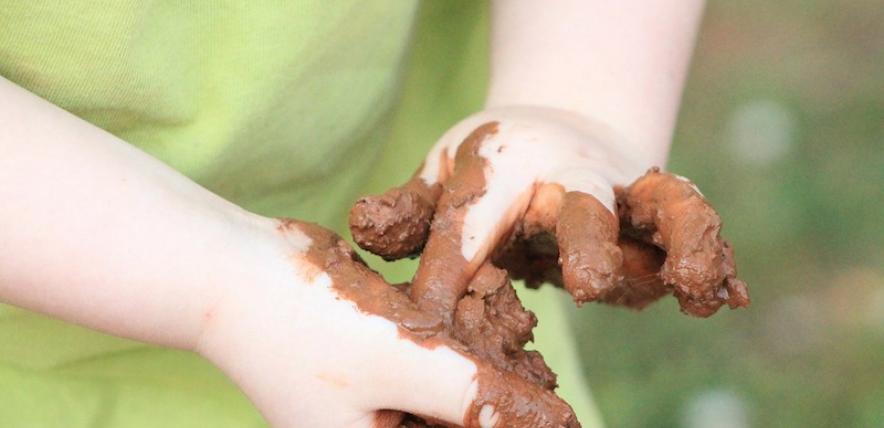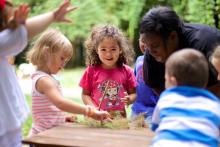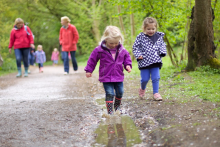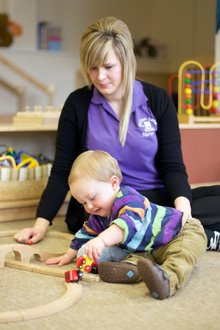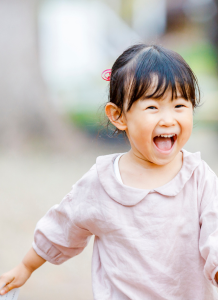Children never need an excuse to play in the mud.
More often than not, parents can find many excuses why they shouldn’t: “You’ll get your clothes dirty,” “You will make a mess,” “You will walk that into the carpet,” to name but a few!
When presented with a muddy child, we often respond with an exasperated: “Just look at the state you are in!”
Our focus is often on the consequences of muddy play: dirty clothes, faces and hands. But the process involved in any play activity can be very meaningful and important for their learning and development.
If we take a look at the “state” of a muddy child, the chances are that they will have been completely engrossed in their muddy activity for some time.
They will be oblivious to the condition of their hands and clothes and are likely to be smiling broadly and satisfied with what they have achieved.
That might be digging a hole in the ground and filling it in again, or moving soil from one place to another.
Fun and free
Mud is a brilliant resource, one that is often much maligned. This is a shame because getting dirty is simply a by-product of a play activity that is free, offers great scope for learning and is in endless supply.
Children do not need to be directed to play with mud – they are inextricably drawn to it.
A muddy, sticky slippery patch of dirt is irresistible to most children, which makes it an ideal resource to stimulate learning.
The muddy child has ‘played with and explored’ the properties of mud as they use their senses to discover how it feels, how it behaves and how it smells.
They will have been actively learning as they concentrate on their play, showing fascination and gaining satisfaction from their efforts. They will have been creatively and critically thinking as they find new ways to use mud, testing out ides and solving problems.
Physical and mental benefits of mud play
Researchers from Bristol University and University College London have studied the connection between healthy immune systems and mental wellbeing.
They looked at the effects of a ‘friendly’ bacteria found in the soil – mycobacterium. The conclusion was that exposure to this bacteria could activate neurons in the brain that contain serotonin, the chemical said to help regulate mood, social behaviour, appetite, digestion and sleep. Contact with the many bacteria in mud can also help children to develop strong immune systems.
Thankfully, the emphasis on getting children to be active and engaged with the outdoors continues to increase in momentum, driven by the alarming rise in childhood obesity and concerns over children’s mental health. Early years practitioners have a vital role to play in helping shape children’s attitude towards the outdoors and how they engage with nature that will stay with them for life and it all begins with a handful of mud.
Muddy thoughts
Create a mud kitchen – You don’t need a purpose-built mud kitchen and certainly not a plastic representation. If you have any outdoor space at home, children can use kitchen equipment to make mud pies. A few bricks and planks of wood can be used to create an oven. Add plenty of pots, pans and course some water. The children will do the rest.
Make a mud face – Let children scoop a handful of soft, sticky mud onto a tree trunk and sculpt a face. If you are lucky enough to have a few trees in your garden there will be plenty of scope for the children to create a mini forest of weird and wonderful creatures whose faces change as they are exposed to the elements. Set children’s imaginations to work as they give their tree faces names and encourage them to notice the features of the tree.
Make mud castles – All you need to provide are buckets and spades. Mud is actually more workable than sand, so children will get more satisfaction from a mud-castle that does not collapse when it dries out, and actually becomes more durable. If you have more than one child they could work together to create one big castle and will then have fun digging a moat, which can be filled with water.
Squish your toes in mud – Walking barefoot in mud is an extraordinary experience that will delight most children.
Potential problems
While mud is great, there are some things you need to consider. Not all children will be happy about getting really muddy. Don’t make them get muddy if they don’t want to. They will probably join in later on, when they are ready.
Mud can stain clothes, so make sure children are dressed appropriately in old clothes or in special ‘splash suits’.
Be aware of the need for good hygiene here too. Don’t create your muddy play area in a space where there could be animal faeces.
Always make sure children wash their hands thoroughly after mud play and discourage toddlers from putting their fingers in their mouths.
If you are concerned about the cleanliness of your mud, buy a bag of peat-free compost and fill an old paddling pool with it instead.
By Melanie Pilcher — Quality and Standards Manager at the Early Years Alliance
Where next?
Boosting your child's listening skills
Wonderful ways to enjoy the wind
Why you should encourage make believe play

